We have provided you with Extra and Important Questions from Class 10 Science Chapter 11 Human Eye and Colourful World. This Extra and Important Questions will help you to score 100% in your Board Exams. These extra questions will be helpful to revise the important topics and concepts.
Join our Telegram Channel, there you will get various e-books for CBSE 2024 Boards exams for Class 9th, 10th, 11th, and 12th.
Table of Contents
Human Eye and Colourful World Class 10 Important Questions with Answers Science Chapter 11
Extra Questions for Class 10 Science Chapter 11 Very Short Answer Type
Question: Why do stars appear to twinkle?
Answer: Stars appears to twinkle due to atmospheric refraction.
Question: Why is the colour of the clear sky blue? (NCERT Exemplar)
Answer: Colour of the clear sky is blue: The molecules of air and other fine particles in the atmosphere have size smaller than the wavelength of visible light.
When sunlight passes through the atmosphere, the fine particles in air scatter the blue colour more strongly than red.
Question: Define farthest point of an eye.
Answer: Farthest point of an eye: The farthest point upto which the eye can see objects clearly is called far point of the eye. It is infinity for normal eye.
Question: Define power of accommodation.
Answer: Power of accommodation: The ability of the eye lens to adjust its focal length is called accommodation.
Question: Define least distance of distinct vision.
Answer: Least distance of distinct vision: Minimum distance at which an object can be seen distinctly without any strain from the normal eye, i.e., 25 cm for normal vision.
Question: Define Tyndall effect.
Answer: Tyndall effect: The phenomenon of scattering of light by colloidal particles gives rise to Tyndall effect.
Tyndall effect can be observed when sunlight passes through a canopy of a dense forest. Here tiny droplets in mist scatters light.
Question: Define atmospheric refraction.
Answer: Atmospheric refraction: If physical conditions of the refracting medium (air) are not stationary, the apparent position of the object fluctuates.
Question: Why are danger signal lights red in colour?
Answer: Danger signal lights are red in colour because red colour is least scattered by fog or smoke.
Question: Why is red colour selected for danger signal lights?
Answer: Wavelength of red colour is more and so, it is least scattered. It can be easily seen through a large distance.
Question: Name the part of our eyes that helps us to focus near and distant objects in quick succession.
Answer: Ciliary muscles help in changing the focal length of the eye lens.
Question: A person is advised to wear spectacles with concave lenses. What type of defect of vision is he suffering from?
Answer: Myopia or short-sightedness.
Question: A person is advised to wear spectacles with convex lenses. What type of defect of vision is he suffering from?
Answer: Hypermetropia or far-sightedness.
Question: Why do different components of white light deviate through different angles when passing through a triangular glass prism?
Answer: Due to change in refractive index offered by the medium.
Question: A person can comfortably read a book but finds it difficult to read the number on a bus parked 5 m away from him. Name the type of defect of vision he is suffering from. Which type of lens should he use in his spectacles to correct his vision?
Answer: Myopia or short-sightedness. Concave lens should be used to correct his vision.
Question: What will be the colour of the sky, when it is observed from a place in the absence of any atmosphere? Why?
Answer: Sky appears dark.Reason: In the absence of atmosphere, there would have been no scattering of sunlight at all.
Question: The sky appears dark instead of blue to an astronaut. State its reason.
Answer: The sky appears dark to the astronaut as scattering does not take place at very high altitude due to the absence of atmosphere.
Question: Give an example of optical phenomena which occurs in nature due to atmospheric refraction.
Answer: Twinkling of stars.
Question: Give an example of a phenomenon where Tyndall effect can be observed.
Answer: When a fine beam of sunlight enters a room containing suspended particles of dust, the path of the beam of light is visible. It is due to the scattering of light (Tyndall effect).
Extra Questions for Class 10 Science Chapter 11 Short Answer Type
Question: Why does the sun appear reddish at sunrise?
Answer: At sunrise, the sun looks almost reddish because only red colour ( λb < λr ), which is least scattered is received by our eye and appears to come from the sun. Hence, the appearance of sun at sunrise, near the horizon may look almost reddish.
Question: Student sitting at the back bench in a class is not able to see what is written on the blackboard. He however, sees it clearly when sitting on the front seat at an approximate distance of 1.5 m from the blackboard. Draw ray diagrams to illustrate the image formation of the blackboard when he is seated at the (i) back seat (ii) front seat.
Answer: (i) When student is seated at the back seat.

(ii) When student is seated at front seat.

Question: What is meant by spectrum of white light? How can we recombine the components of white light after a prism has separated them? Draw a diagram to illustrate it.
Answer: The coloured pattern VIBGYOR formed by a prism by splitting the incident white light is called a spectrum. By having two prisms, inverted to each other, one can recombine the light to get white light again.
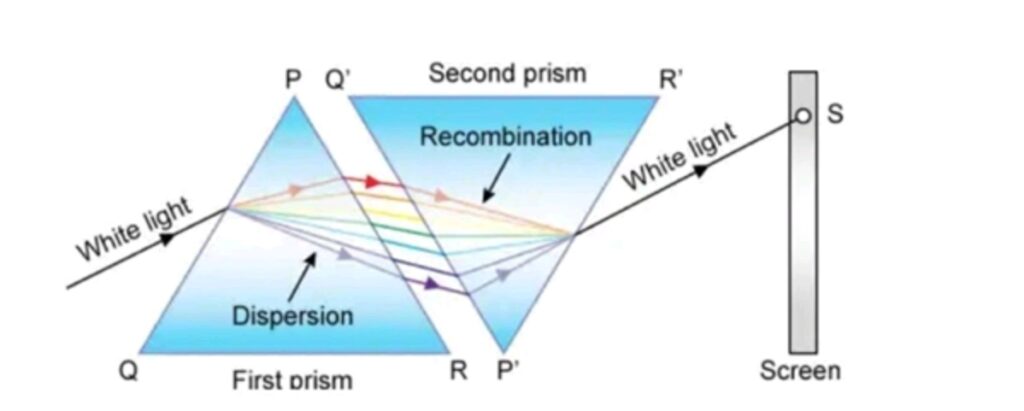
Question: Explain why do the planets not twinkle but the stars twinkle.
Answer: Planets being of larger size can be taken as a collection of large number of point-sized objects/sources of light, which nullify the twinkling effect of each other.
Due to varying conditions of atmosphere, starlight undergoes multiple refraction and its path varying slightly while passing through the atmosphere. Therefore, the apparent position of star fluctuates and amount of light entering the eye changing continuously. The star sometimes appear brighter and some other time, it appears fainter. This causes twinkling of star.
Question: What is myopia (near-sightedness)? Draw a ray diagram to show how it can be corrected using a lens.
Answer: Myopia is the inability of an eye in viewing long distant objects. The image in this case is formed before the retina. For every myopic eye, there exists a far point beyond which clear image cannot be seen.
The short-sightedness is corrected by using a concave lens which diverges and shifts the image to the retina.
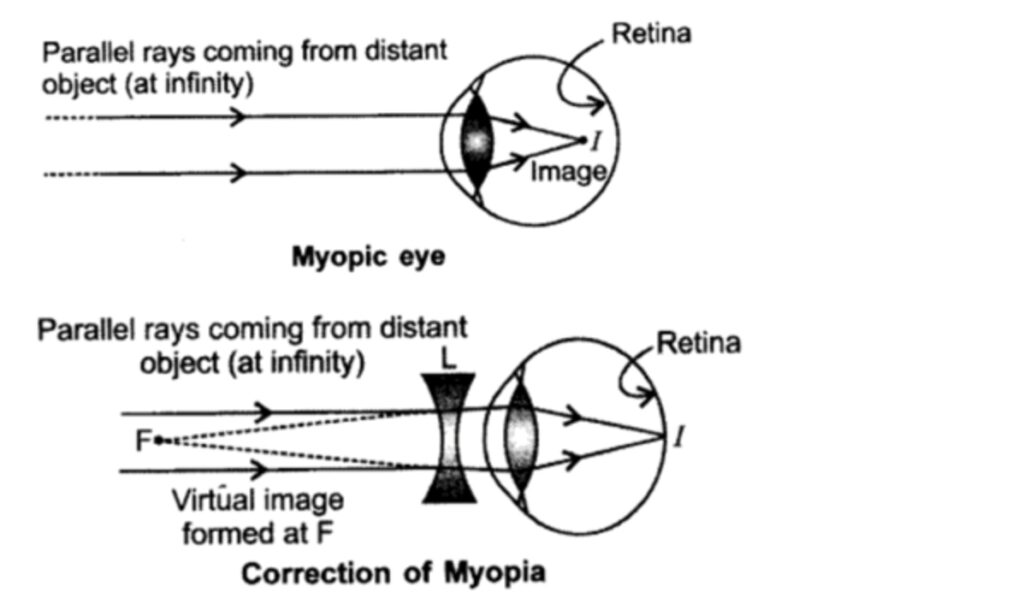
Question: Define the term dispersion of white light. State the colour which bends (i) the least and (ii) the most while passing through a glass prism.
Answer: The splitting up of white light into its component colours is called dispersion. The colour which bends (i) the least is red, and (ii) the most is violet, while passing / through a glass prism.
Question: A star appears slightly higher (above) than its actual position in the sky. Illustrate it with the help of a labelled diagram.
Answer: The gradual change in the refractive index of different layers of the atmosphere due to the varying conditions of it causes atmospheric refraction. When starlight enters the atmosphere, it gets refracted continuously. The higher level of air acts as a rarer medium while the dense air near the surface of earth acts as a denser medium. So, the atmosphere bends the starlight towards the normal. As a result, the apparent position of star is slightly different from its actual position. Thus, star appears slightly higher (above) than its actual position in the sky.
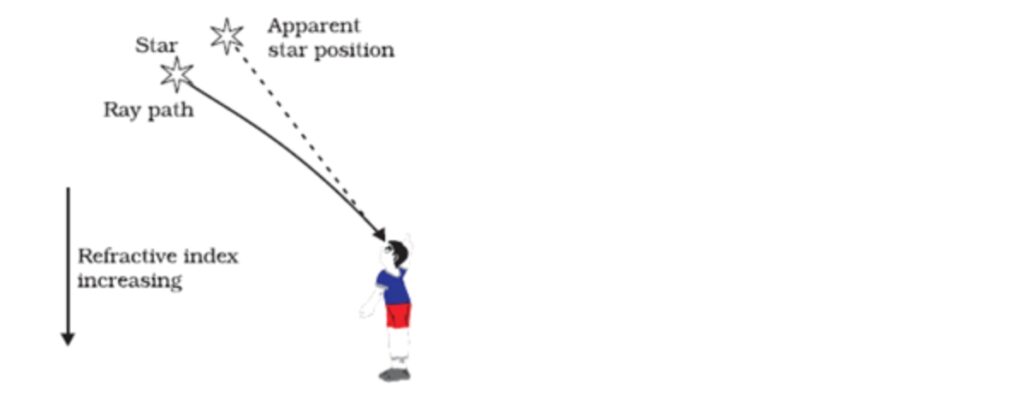
Question: A star sometimes appears brighter and some other times fainter. What is this effect called? State the reason for this effect.
Answer: This effect is called Twinkling effect.
Reason: It is due to atmospheric refraction of starlight. The atmosphere has varying layers. The gradual change in the refractive index of different layers of atmosphere causes atmospheric refraction and starlight undergoes multiple refraction. So, the fluctuation in the position of star occurs continuously due to the changing amount of light entering the eye. The star sometimes appears brighter and at some other times, it appears fainter. This causes twinkling of star.
Question: Explain formation of rainbow.
Answer:
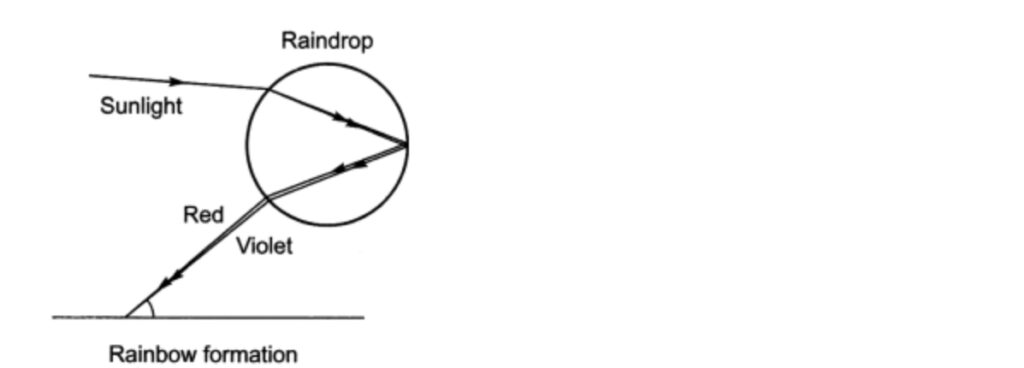
Rainbow formation: A rainbow is a natural spectrum appearing in the sky after rain shower. It is caused by dispersion of sunlight by tiny water droplets, present in the atmosphere. The water droplets act like small prism. They refract and disperse the incident sunlight, then reflect it internally and finally refract it again.
Due to dispersion of light and internal reflection different colours appear.
Question: What is the difference in colours of the sun observed during sunrise/sunset and noon? Give explanation for each.
Answer:In the morning and evening, the sun lies near the horizon. Sunlight travels through a larger distance in the atmosphere and most of the blue light and shorter wavelengths are scattered away by the particles. Therefore, the light that reaches our eyes is of longer wavelength. This gives rise to the reddish appearance of the sun.
At noon sun appears white as only a little of blue and voilet colours are scattered.
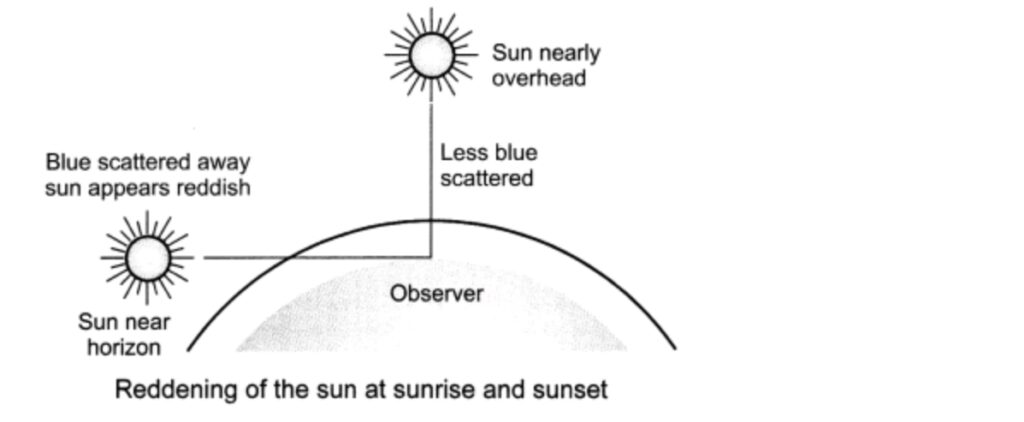
Extra Questions for Class 10 Science Chapter 11 Long Answer Type
Question: List four common refraction defects of vision. Suggest the way of correcting these defects. (CBSE 2014)
Answer: Defects of vision:
(i) Cataract: Crystalline lens of people at old age becomes milky and cloudy. This condition is called cataract.It is possible to restore vision through cataract surgery.
(ii) Myopia: (Near sightedness)A person with myopia can see nearby objects clearly but cannot see distant objects clearly.
Cause:
- Due to excessive curvature of the eye lens.
- Elongation of the eyeball.
Correction:Concave lens of suitable power.
(a) Far point of myopic eye

(b) Myopic eye

(c) Correction for myopia

(a), (b) The myopic eye, and (c) correction for myopia with a concave lens
(iii) Hypermetropia (far-sightedness): A person with hypermetropia can see distant objects clearly but cannot see nearby objects distinctly.
Cause:
- The focal length of the eye lens is too long.
- The eyeball has become too small.
Correction:Convex lens of suitable power.
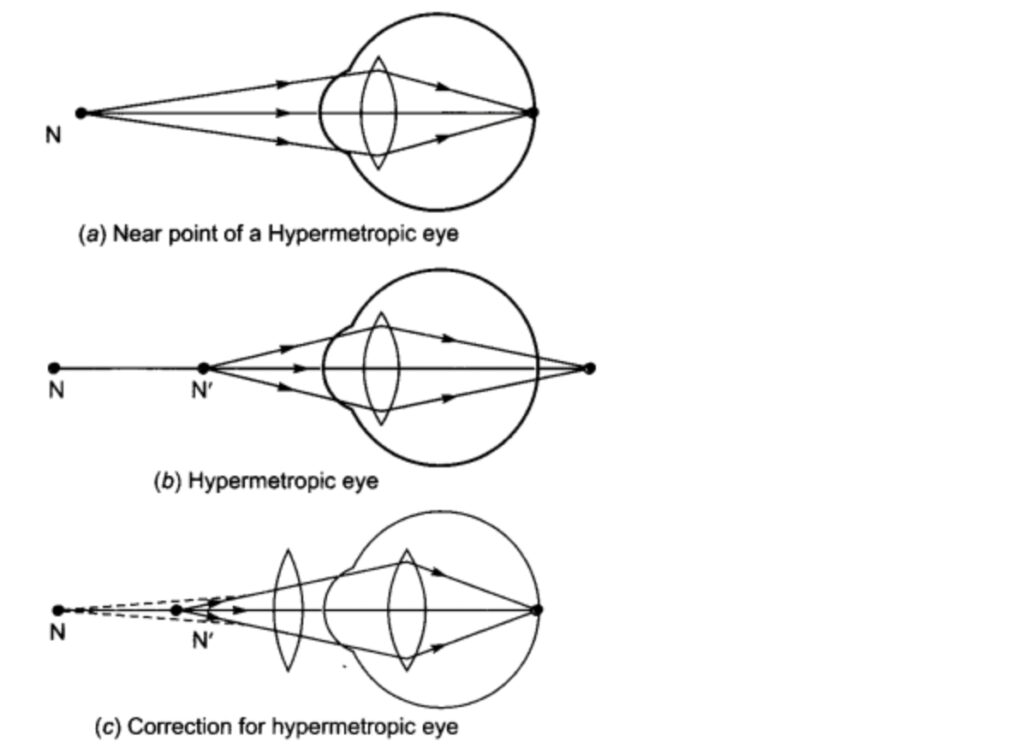
(a), (b) The hypermetropic eye, and (c) correction for hypermetropia
(iv) Presbyopia : The power of accommodation of the eye usually decreases with ageing. In this eye defect it is difficult to see nearby objects comfortably and distinctly without corrective eye glasses.
Cause:Weakening of ciliary muscles and diminishing flexibility of eye lens.
Correction:By using Bifocal lens: Upper portion consists of concave lens and lower part is convex lens.
Question: Explain the structure and functioning of the human eye. How are we able to see nearby as well as distant objects?
Answer:
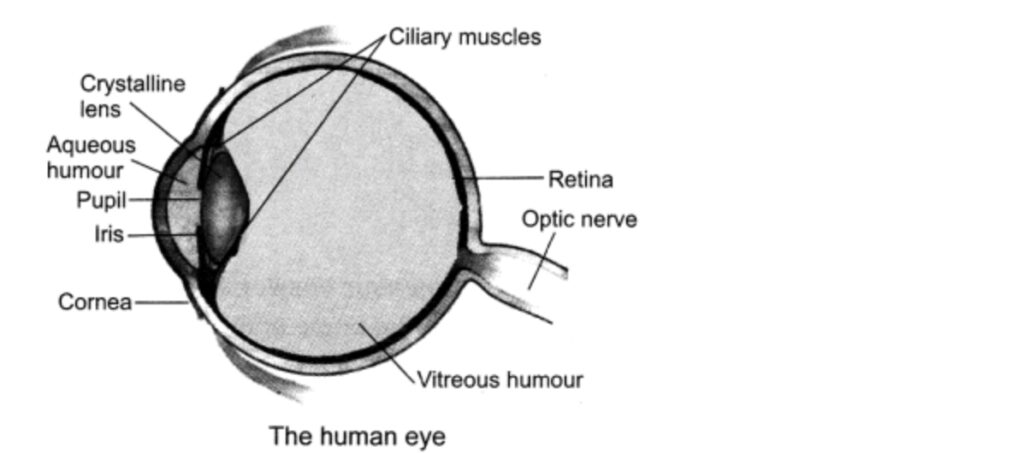
- Cornea: A thin membrane through which light enters the eye, maximum refraction occurs at the outer surface of cornea.
- Iris: A dark muscular membrane which controls size of pupil.
- Pupil: Regulates and controls the amount of light entering the eye.
- Eye lens: Composed of fibrous, jelly like material, with adjustable curvature, forms an inverted and real image of object at retina.
- Retina: It is a light sensitive screen on which image is formed.
Question: How will you use two identical prisms so that a narrow beam of white light incident on one prism emerges out of the second prism as white light? Draw the diagram.
Answer: When an inverted prism is kept a little distance away from the prism causing dispersion or basically in the path of splitted beam, the spectrum recombines to form white light.

Question: What is a spectrum? Why do different coloured rays deviate differently on passing through a glass prism?
Answer: The band of coloured component of a light beam is called its spectrum. The colour sequence is given by the acronym V I B G Y O R — Violet, Indigo, Blue, Green, Yellow, Orange and Red.
The speed of light of different colours in a medium like glass is different. Varying speeds for different colours lead to different refractive indices for different colours. It has been observed that the refractive index of glass for violet colour is more than that for red colour. All the colours present in white light refract through different angles and hence, emerge out from the prism with different directions and become distinct.
Question: (a) What is meant by the power of accommodation of an eye?
(b) A person with a myopic eye cannot see objects beyond 1.2 m directly.
What should be the type of the corrective lens used? What would be its power?
Answer: (a) The maximum variation in power of the lens so that the far-off and nearby objects are viewed clearly is called power of accommodation.
(b) To correct, an object at infinity has to be brought as an image to 120 cm
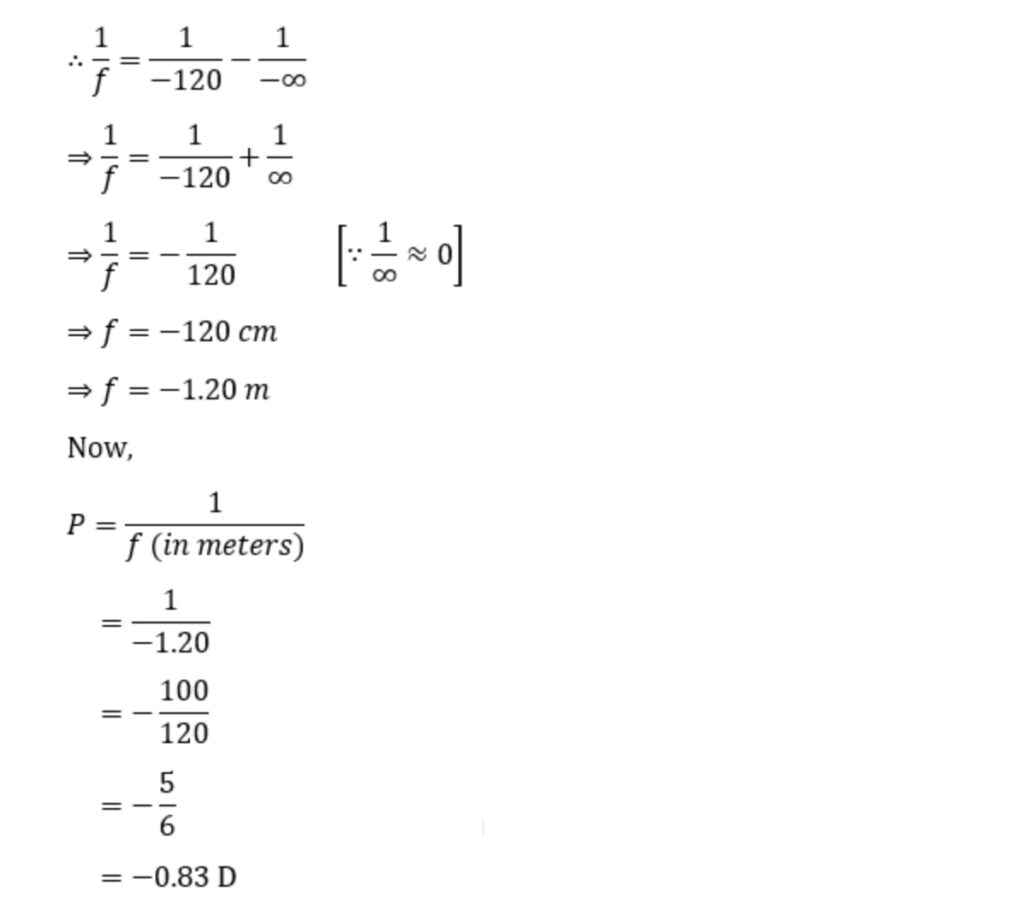
Question: What is meant by the term ‘power of accommodation’ of human eye? How does it help a person to see nearby as well as distant objects clearly.
Answer: The ability of eye lens to adjust its focal length to form the sharp image of the object at varying distances on the retina is called its power of accommodation. When we see the nearby object, the ciliary muscles contract, it increases the thickness of eye lens. The eye lens then becomes thicker. As a result, the focal length of eye lens decreases in such a way that the clear sharp image of nearby object is formed on the retina. Thus, the object is seen clearly to us.
When we see the distant object, these muscles become relaxed, thus the eye lens becomes thinner, and consequently focal length of the lens increases. Therefore, the parallel rays coming from the distant object are focused on the retina and object is seen clearly to us. Thus, the accommodation power of an eye helps a person to see nearby as well as distant objects clearly
Question: (a) Explain the following terms used in relation to defects in vision and correction provided by them:
- Myopia
- Astigmatism
- Bifocal lenses
- Far-sightedness.
(b) Why is the normal eye unable to focus on an object placed within 10 cm from the eye?
Answer: (a)
- Myopia: Short-sightedness is caused due to excessive curvature in cornea or elongation of eyeball. Image is formed before of the retina. So, a concave lens is used to correct it.
- Astigmatism: The inability to focus the light in both vertical and horizontal lines is called astigmatism. It is caused due to varying curvature in lens both horizontally and vertically. It is corrected by using cylindrical lens.
- Bifocal lenses: These are used to correct presbyopic eye. These contain lenses with upper concave and lower convex surface. Presbyopia arises with age.
- Far-sightedness: Hypermetropia or far-sightedness is caused due to greater focal length of eye lens and/or when eyeball becomes smaller. Image is formed beyond the retina and can be corrected using a convex lens.
(b) The focal length of the lens cannot be changed up to an extent that objects nearer than 25 cm can be viewed (its near point is 25 cm). So it is not able to focus for 10 cm.



